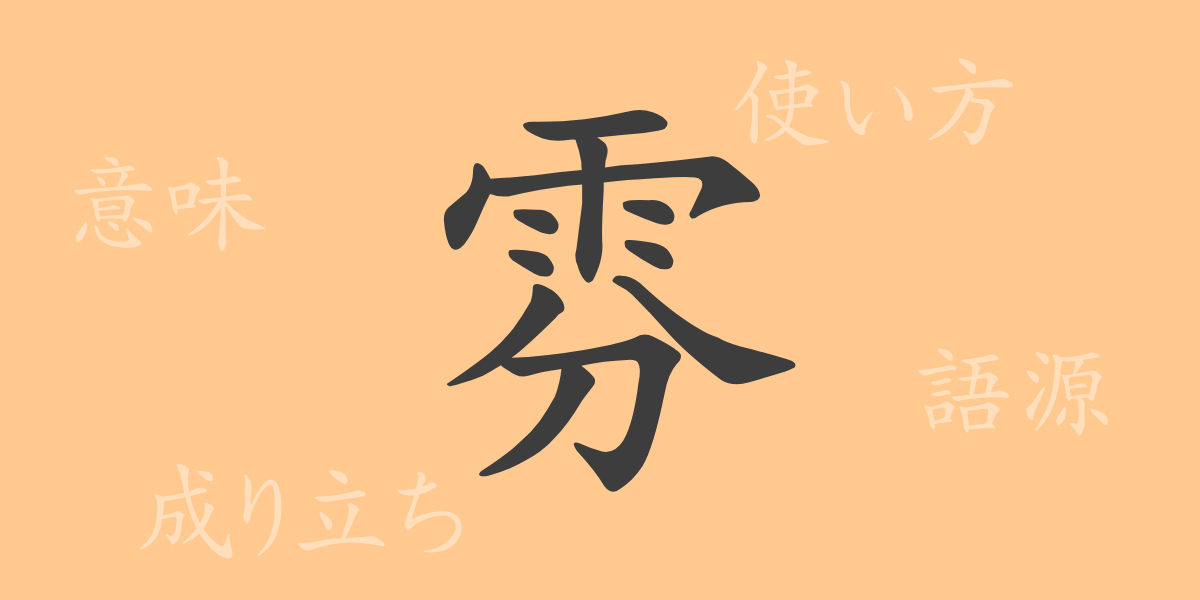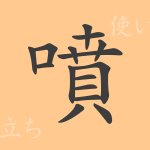The beauty of the Japanese language is reflected in its delicate characters. This time, we spotlight the 常用漢字 (じょうようかんじ, Jōyō Kanji) “雰” (ふん, fun) and delve into its charm. This single character embodies a deep understanding of Japan’s nature and culture, making it a keyword that lets you feel the profound depth of the Japanese language. The “雰” (ふん, fun) in “雰囲気” (ふんいき, fun’iki) — do you know everything about this kanji?
- Origin of “雰” (語源, ごげん, gogen)
- Meaning and Usage of “雰” (意味と用法, いみとようほう, imi to yōhō)
- Reading, Stroke Count, and Radical of “雰” (読み方・画数・部首, よみかた・かくすう・ぶしゅ, yomikata, kakusū, bushu)
- Idioms, Proverbs, and Expressions Using “雰” (熟語・慣用句・ことわざ, じゅくご・かんようく・ことわざ, jukugo, kan’yōku, kotowaza) and Their Meanings
- Summary of “雰” (まとめ, まとめ, matome)
Origin of “雰” (語源, ごげん, gogen)
The kanji “雰” (ふん, fun) is an ideogram inherited from ancient China. It combines the “雨” (あめ, ame) radical, which means rain, with “分” (ぶん, bun), which means to divide, representing the image of rain dividing into mist or clouds. This character, which depicts a natural phenomenon, symbolizes the unique atmosphere or environment created by rain and mist in its formation process.
Meaning and Usage of “雰” (意味と用法, いみとようほう, imi to yōhō)
The kanji “雰” (ふん, fun) is often used in the word “雰囲気” (ふんいき, fun’iki). This refers to the unique air, aura, or environment of a place, possessing an abstract yet powerful appeal to people’s senses. In meteorology, it can also be used to describe climate or weather. In Japanese, “雰” (ふん, fun) is primarily used to express environments, weather, and sensory experiences.
Reading, Stroke Count, and Radical of “雰” (読み方・画数・部首, よみかた・かくすう・ぶしゅ, yomikata, kakusū, bushu)
How is the kanji “雰” (ふん, fun) read in Japanese, and what is its structure?
- Reading: In 音読み (おんよみ, onyomi) it is “フン” (ふん, fun); there is no 訓読み (くんよみ, kunyomi).
- Stroke Count: It has a total of 12 strokes.
- Radical: The radical is “雨” (あめ, ame), classifying it among kanji related to weather.
Idioms, Proverbs, and Expressions Using “雰” (熟語・慣用句・ことわざ, じゅくご・かんようく・ことわざ, jukugo, kan’yōku, kotowaza) and Their Meanings
Idioms, proverbs, and expressions that include “雰” (ふん, fun) richly express the meanings and sensations the word holds. Here are some examples:
- 雰囲気 (ふんいき, fun’iki): The unique air or aura of a place.
- 雰囲気作り (ふんいきづくり, fun’iki-dzukuri): The act of creating a specific atmosphere.
- 雰囲気読み (ふんいきよみ, fun’iki-yomi): The act of sensing the situation and taking appropriate action.
Summary of “雰” (まとめ, まとめ, matome)
The kanji “雰” (ふん, fun) has a unique presence in the Japanese language. From its formation background to its readings, stroke count, radical, and the idioms and expressions it forms, the depth and breadth of meaning this single character holds can be said to represent the “雰囲気” (ふんいき, fun’iki) we unconsciously perceive in our daily lives. “雰” (ふん, fun), with its power to shape sensations through words, is one of the kanji that symbolizes the richness of the Japanese language.

























